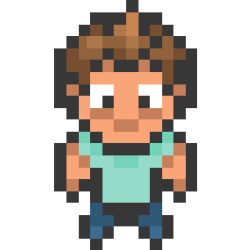Art Production on Element Arena - Part 2: Concept Art Philosophy & Deliverables

This article outlines our Concept Art Deliverables deck. I'll go over our process with a full example including feedback revisions with a full example. This allowed our art team to execute smoothly inline with our expectations. If you missed it, see Part 1 that outlined our Art Direction.
Firstly in this deck, I clarified our philosophy on feedback and revisions at Gamelynx, and then I outlined the specific milestones and deliverables.
Philosophy
I encouraged artists to be extra rough in early drafts. I wanted them to be comfortable exploring ideas quickly and keep iteration costs down. You should only have to make it pretty once. I didn't push too hard as obviously people have their comfortable working quality level, but it makes sense to save the dazzling quality for when we aren't going to potentially immediately throw it in the bin.
A big reason why concept art isn't always rough (besides a freelancer wanting to impress to get more work) is that many clients can't evaluate options well without polish--or appreciate intentional drops in quality. It's good to understand how your artists like to work so you can support them in effective rapid iteration.
From what I've experienced there are two high-level ways concept artists approach things: shapes-first or meaning-first (thank you Hans for these terms!). Shapes-first art comes from composing good shapes, and then later worry about the meaning of those shapes. Their roughs can be really rough! Meaning-first art comes from when there is already a concrete idea of a character and how their armor straps work before the drawing even starts. Meaning-first art is more defined and can take a bit longer to finish. The benefit is that you get a more formed character idea and identity from the outset.
Obviously, the point of concept art is to convey the concept and make decisions. By encouraging artists that you're comfortable with roughs, you can have earlier discussions and move faster. It's completely okay if you want detailed roughs to make an informed decision, but it wasn't needed for us so I wanted them to feel free to go fast and loose. This allowed us to comfortably go through between 5-30 rough sketch variants on a concept and still have a perfectly fine time budget overall.
All feedback would be asynchronous and written in work chat. I wrote up my feedback along with paint overs such that everything would be always there for reference. Since the whole art team was remote, this set us up well for good communication practices while still having a fluid chat environment to follow up with things on. I offered voice chats whenever it made sense, but for the most part it wasn't needed. Examples provided below.
Deliverables Structure & Example
In each deliverable, we would iterate with rounds of feedback until we were satisfied to move to the next step. I'll use a real example, but I'll omit a lot of the discussion and feedback for brevity's sake. This is how we created Lucy Steel, the first Grenadier Class character in the game.
Deliverable 0: Concept Brief Feedback and Questions
- Make sure the team is aligned, understands the brief and is confident to start
Honestly, this brief wasn't very detailed, as I trusted Hans to explore with very little guidance at this point. I still chose this example though because the iterations were really fun. There will be more specifics on how we did more formal briefs using our character generation tool in Part 3.
'Military Gunperson'
- familiar but otherworldly military motifs
- an insignia for the faction they represent
- in a grunt squad, and they received the exclusive opportunity to train in the arena. a chance to prove themselves, and hone skills
- big gun, shoots a big thing
- rocket boots that help them stay planted and move around (or other rocket ideas welcome)
- Grenadier class, will shoot bouncy projectiles and have a forward propulsion dash
Deliverable 1: 5 Rough Exploration Sketches
- ~30-45 minutes each
- Followed by feedback to inform next round of explorations
- I sometimes offered 'play with' ideas that are not required
- We sometimes did this round more than once just to get more ideas on paper


Feedback Sample:
Hey @Hans, I really love the pleated cloth, armor, and general medieval+guns vibe you got in your last gunman iteration. This seems right for the gun-loving military group!
2) is sweet and I think we will revisit him for the future for someone with more of a flamethrower/minigun type thing going on.
5) is where it is at. Love the armor and setup here. Let's take this one, but iterate on guns and face.
- Would like to explore an identity that isn't just default Caucasian.
- For the gun would like to explore longer barrel two handed weapons, among others
Deliverable 2: Continued Exploration Sketches
- ~30-45 minutes each
- Informed by feedback to see what is set and what needs more exploration
- Brief may need to discussed and amended
- Continues until the character is set

Feedback Sample:
Let's go with the original sketch, thank you for the variations!
- Ditch the eye wound + patch, and let's switch it to a 'Scouter' type thing like in Dragonball Z to bring in some magic tech, as well as to explain the accurate hip-firing of her weapon (reference attached)
- We still need the 'rocket propulsion' component to be visible. Rocket/wheelie boots, jet pack thrusters on her hips, something

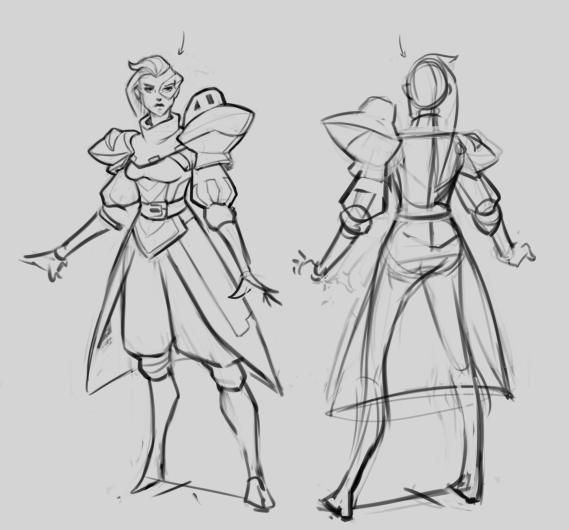
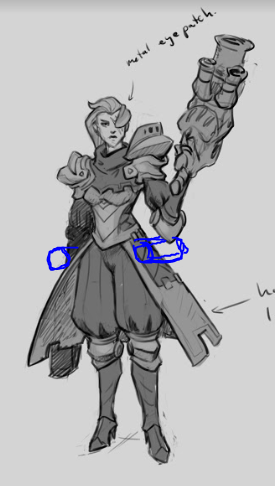

Feedback Sample:
Hey Hans! Lookin' good.
A few things:
- Hair looks odd with the top of the hair parted on the opposite side of the undercut, and then slicked around. Everything should be flowing away from the undercut, more like your other rough sketches
- Scouter goes really high on her skull at the back, it looks odd and wouldn't be a good designed piece of tech for anyone that doesn't have an undercut. it should just hang on top of the ear like glasses
- Thrusters look good! I would just ditch the power generator and cables on her back. We can just claim it's integrated into her skirt armor. The reason for this is to simplify silhouette.
- In a side general point, I appreciate the attempt at consistency, but thematically I wouldn't use the same generator here as the inventor as they're from different places. The Inventor does things his unique way. It's claptrap and powered by a stolen fire spirit. This person uses the medieval looking military gear that is mass produced. It wouldn't make sense for them to be the same (though it does look good visually).
Deliverable 3: In Game Mock
- ¾ Camera perspective
- Use in game screenshot as background if needed
- Ensure design and details works with in game view

Deliverable 4: Front Pose Line Art
- Time to make it pretty!
- Front posed, with clean lines and toon shading
- We would skip straight to Color Composition before giving feedback again if the design was finalized enough

Deliverable 5: Color Composition
- Explore colors compositions with in game mock and line art
- Up until this point, the concepts were usually grey scale
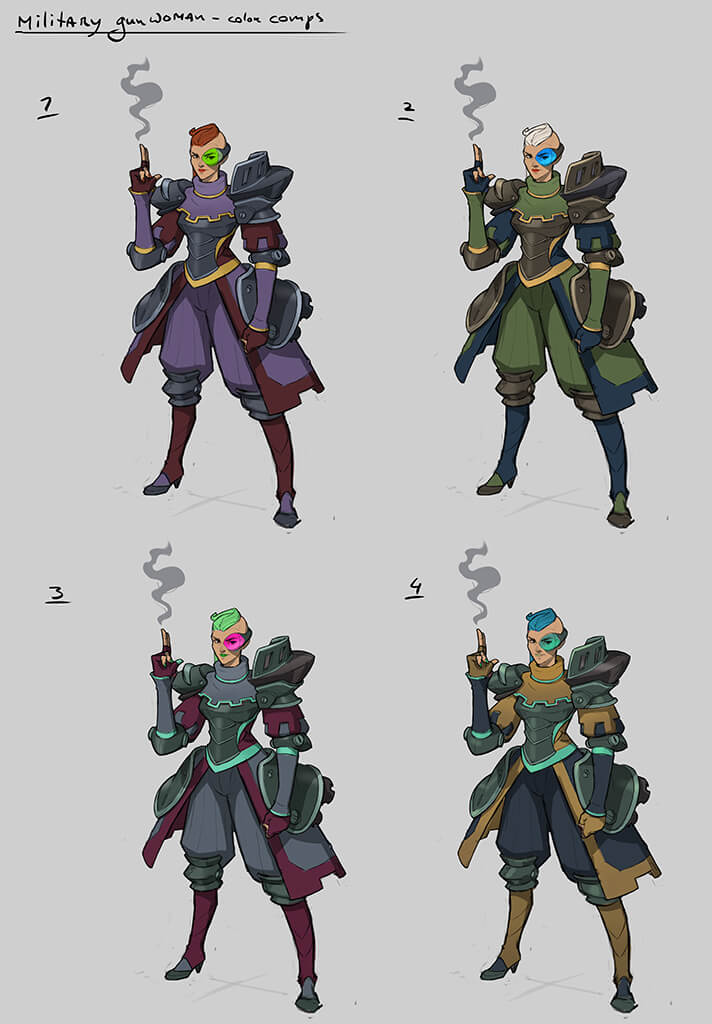

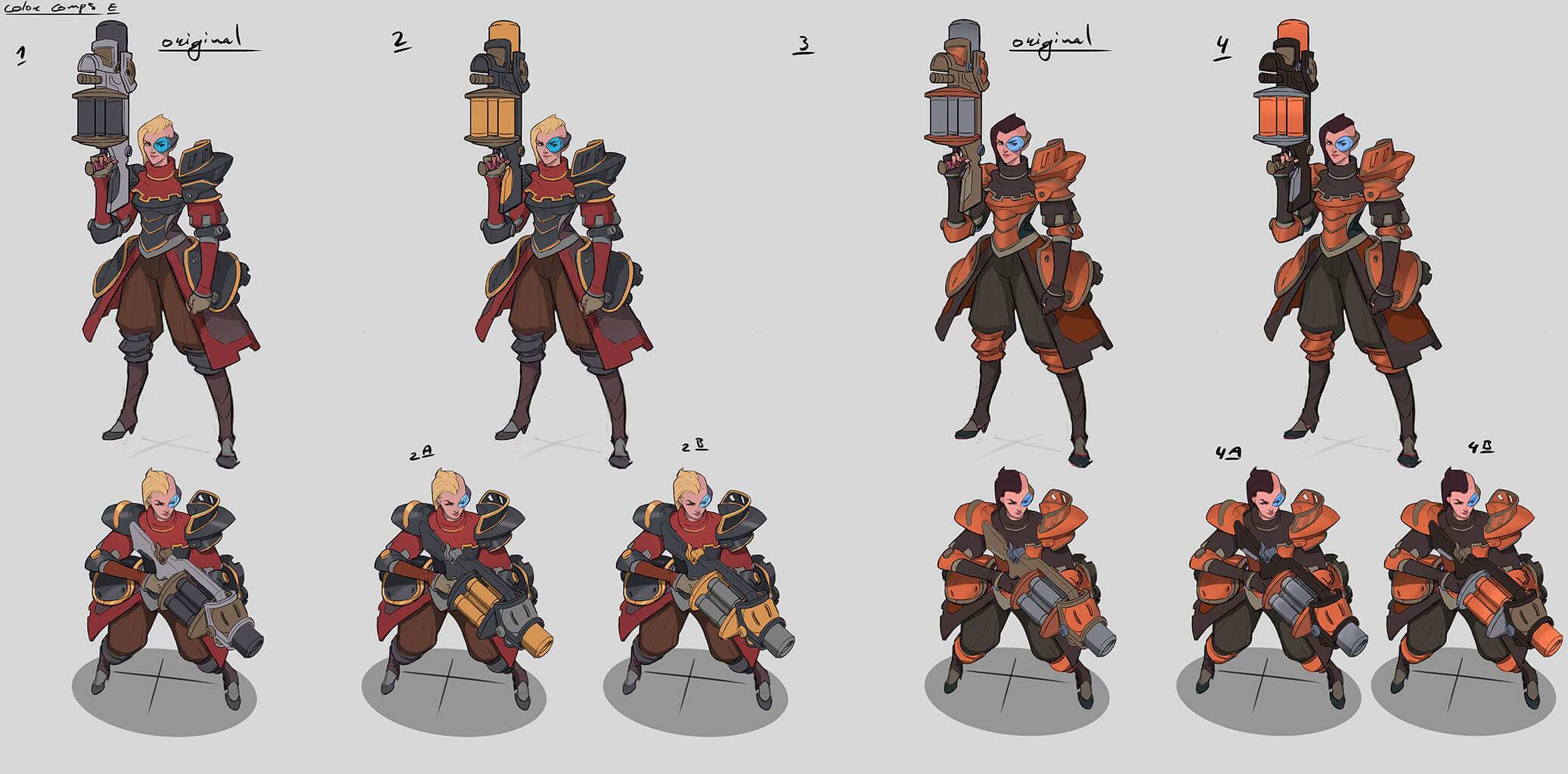

Deliverable 6: Final Asset Sheet
- Asset Sheet, with Gamelynx logo, your name, concept name, date
- Include any additional close ups of any other details needed to assist modelling
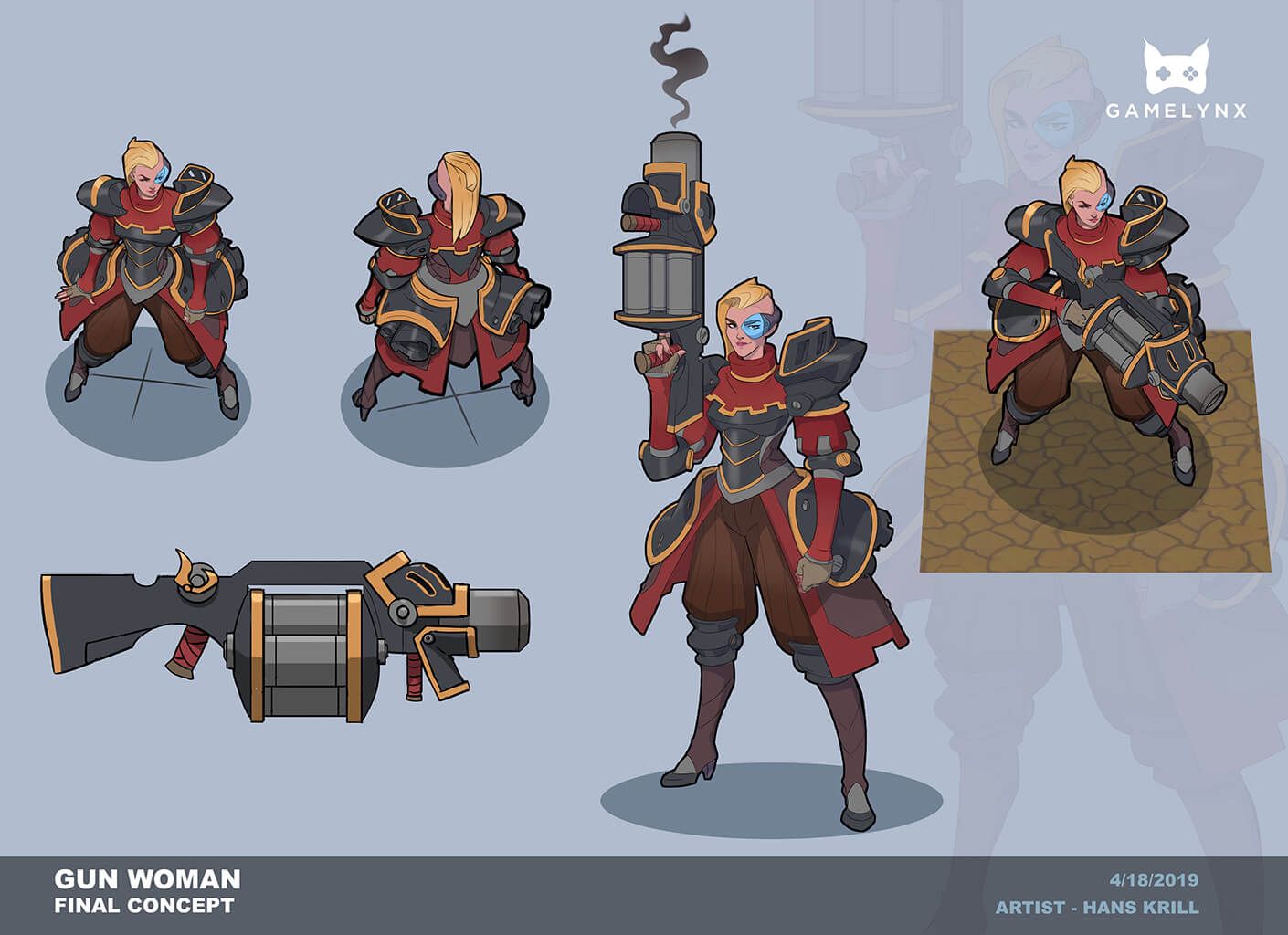
IP Risk Management
I found it interesting how much concept art approval is ensuring that your IP is unique in the broad world of entertainment IP. Obviously you'd aim to create a unique value, but a lot of it comes in not as creative energy but as risk management. We never set out with the goal to copy things closely, but there many times when explorations ended up seeming similar to IP that the artist was unaware of (like an Overwatch character, or a Yu-Gi-Oh card, etc.). We'd have to raise visibility on that and pursue other avenues or make it more uniquely ours. Great artists and art directors have an impressively deep knowledge of reference and IP, which not only helps create great and unique forms of content, but ensures that they can raise visibility and make judgement calls on proposals that are similar to things in popular culture.
Making Decisions
Overall, art production and feedback has a lot decisions, many of which are not critical and many of which are subjective. As a result, this craft results a lot in managing decision fatigue and team moral. Great briefs and process create a creative sandbox where any result the artists create with iterated feedback is a great result. It was important to me to be decisive with clear feedback, in a way that was easy to reference days or weeks later. I hope explaining my process helps you in that journey!
Part three covers how we calculated our art budget and info about our character generation tool that created our concept briefs:

